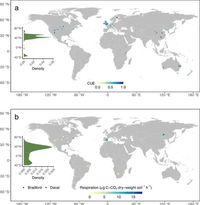In a significant new study published on March 20, 2025, researchers have unveiled a critical relationship between microbial carbon use efficiency (CUE) and temperature, demonstrating that rising mean annual temperatures (MAT) could fundamentally alter soil organic carbon (SOC) dynamics. This research highlights alarming implications for carbon storage in a warming world.
The study observed that as temperatures increase, microbial CUE experiences a nonlinear rise, while heterotrophic respiration—the process by which microbes break down organic matter—shows a corresponding decline. Importantly, this research identified a thermal threshold of approximately 15 °C. Above this temperature, the observed increase in CUE is compounded by rising microbial biomass and respiration rates, indicating a potential for abrupt changes in SOC.
"These nonlinear relationships are mainly associated with changes in the fungal-to-bacterial biomass ratio," wrote the authors of the article, underscoring the intricacy of microbial interactions and their influence on carbon cycling.
The integral role of microbial CUE in SOC storage has gained increasing attention, as it reflects how efficiently microbes convert organic carbon into biomass. The current study leverages three independent soil datasets, combining a robust sample size of 618 for microbial CUE and additional datasets analyzing 591 and 660 measurements for heterotrophic respiration, to strengthen the credibility of its findings.
Utilizing advanced random forest models, the researchers honed in on the significant factors affecting CUE, with MAT being one of the preeminent influences. Through segmented regression analyses, they also established two key MAT thresholds: 1.2 and 16.3 °C for original CUE, and 1.3 and 16.5 °C for detrended CUE.
"Our study thus provides the empirical evidence of a strong nonlinear CUE thermal response..." wrote the authors. This finding contrasts with previous studies which suggested only weak nonlinear trends, revealing that the warming climate might elicit stronger shifts in microbial behavior than previously understood.
Furthermore, the research sheds light on the broader implications of these findings for global carbon cycling. The findings indicate significant SOC losses could occur when mean temperatures surpass approximately 15 °C, suggesting that microbial responses could catalyze accelerated carbon release into the atmosphere, thereby exacerbating climate change.
The segmented regression analysis of the datasets estimated MAT thresholds for respiration to be notably lower in some regions, highlighting the variability in microbial responses across different climatic zones. For instance, the regional Bradford dataset in North America identified a threshold of just 11 °C, highlighting regional differences in microbial adaptation to thermal conditions.
Spatial error model analyses reinforced the need for nuanced understanding; they brought to light how factors such as soil C:N ratios and aridity index also significantly influenced the observed CUE values and their temperature relationships.
Both a first-order SOC model and a more complex, microbial-explicit model were employed to simulate the impacts of the discovered nonlinear temperature response, further confirming that projections for SOC dynamics must account for these intricate microbial processes. As MAT increased, the first-order model predicted significant nonlinear decreases in SOC mass, while the microbial-explicit model suggested that higher CUE could lead to increased decomposition rates, thereby enhancing the loss of SOC.
Finally, the researchers concluded that understanding these microbial dynamics is essential for improving predictive models of SOC responses to climate change. "The results underscore the heterogeneity of SOC responses to warming, with high temperature sensitivity in temperate zones that could drive positive SOC feedbacks to climate warming," wrote the authors of the article.
These findings call for further research to explore the interplay between microbial species composition and soil conditions, thereby fostering more accurate biogeochemical models capable of better predicting climate feedback mechanisms.




